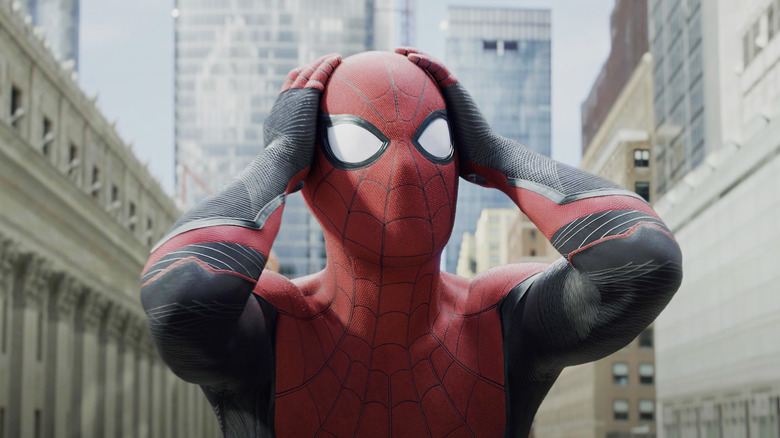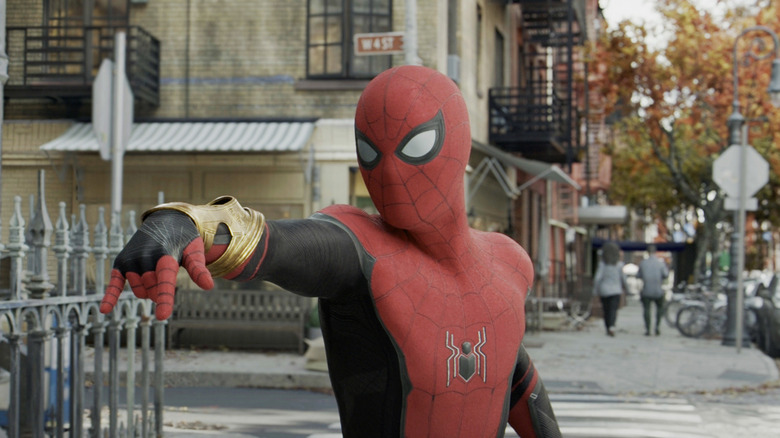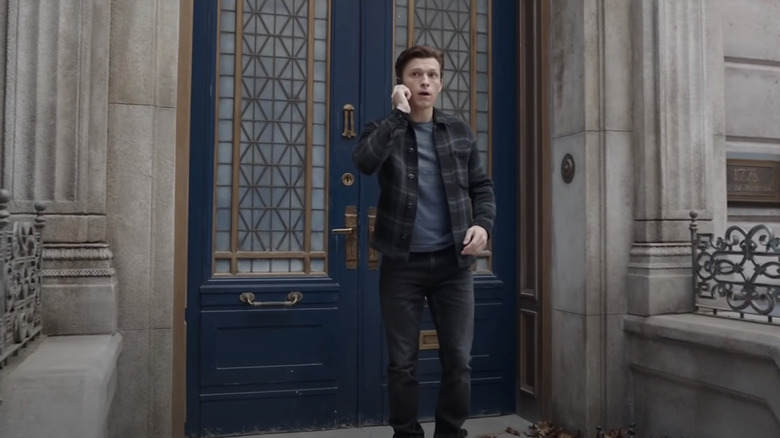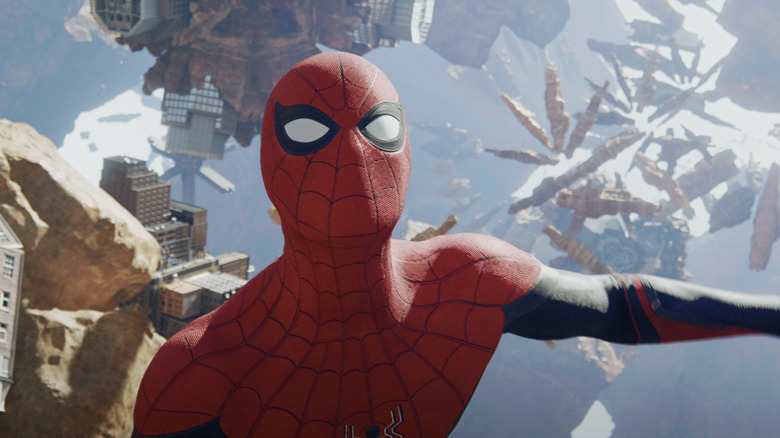Tom Holland Has One Complaint About Marvel's Spider-Man: No Way Home
"Spider-Man: No Way Home" was both a hugely significant cultural moment and, depending on who you ask, a key moment in the arrival of a new cynical era for moviemaking in which pandering to fan expectations takes precedence above all else. The box office performance of "No Way Home" cemented Spider-Man as a cultural phenomenon for the ages, but with its multiple cameo appearances almost eclipsing the need for a coherent or affecting story, the film arguably walked so that a movie like "Deadpool & Wolverine" — dubbed a "soulless act of autofellatio" and "a prayer to corporate onanism" by /Film's Witney Seibold — could run.
That said, even the most skeptical critic would surely have a hard time claiming they didn't have a good time watching "No Way Home" at the theater. The film represents what I believe should be a blueprint for Marvel Studios moving forward: An event movie that you go to see once, have a grand old time, and then go on with your life until the next must-see superhero outing drops.
If you happen to fall into the former camp and view something like "No Way Home" as little more than a cynical nostalgia play and a capitulation to the most infantile fan desires, you might have run into the objection that a lot of people worked hard to bring such a film to fruition, and you shouldn't knock the craft that goes into such a project. Of course, a lot of people probably worked hard to make box office bomb of the year "Borderlands," too. But there is a certain level of craft to "No Way Home" that goes beyond the work put into your usual blockbuster. Specifically, the pandemic made shooting Tom Holland's third outing as Spidey a bit of a nightmare, and the crew had to come up with some ingenious fixes to get around such a problem. Unfortunately, for Holland himself, this created more unforeseen issues.
The pandemic heavily impacted the Spider-Man: No Way Home shoot
"Spider-Man: No Way Home" began filming in October 2020, still relatively early in the pandemic. This had a major impact on the making of the film. Key "No Way Home" scenes had to be changed due to the pandemic and, as director Jon Watts told Variety:
"Before COVID we planned a big New York location shoot with tons of extras. That became impossible. Even the most basic shot, of Peter Parker walking down the street, became a multilayered VFX shot."
In a Vanity Fair piece, you can see Visual Effects Supervisor Kelly Port talking about these shots, explaining how much of the "sets" used in the film were expanded or created entirely using CGI. Simple shots of Peter Parker approaching Doctor Strange's doorway, for instance, were all done against a blue screen, with Tom Holland's performance ultimately superimposed over a CGI background that included, as Port put it, "all the little details [...] digital animated leaves that maybe blow in the wind." The team even created digital doubles for pedestrians that were merely walking on the sidewalk in the background, as well as adding in CGI cars and trees.
This was the state of affairs on the "No Way Home" set, with even dead leaves on the sidewalk having to be created digitally in order to craft the illusion of Peter Parker being in his native New York and not on a soundstage in Atlanta's Trilith Studios. Unsurprisingly, doing things this way threw up a plethora of unforeseen issues on-set, too, including one which completely threw Tom Holland off his game.
Tom Holland's walking issues on the set of No Way Home
Though Marvel Cinematic Universe movies are known for their extensive use of green screens, "Spider-Man: No Way Home" was a different thing altogether. Speaking to Rich Roll on his podcast, Tom Holland revealed just how difficult recreating New York in Georgia was for him personally. "I might have done three days on location," said the actor. "You can feel it in the film, I think."
Interestingly enough, it wasn't the big fight scenes or set-pieces, like the bridge fight in "No Way Home," that Holland found the most difficult to shoot, but the small-scale street-level scenes. As the actor explained it, a crew was sent to New York City to "shoot the streets with a motion camera jib." Then, back in Atlanta, the crew would recreate the layout of those shots in the studio, marking on the floor where certain elements were supposed to go in relation to the NYC footage. As Holland put it, "'There's an extra here. There's a dog here. There's a sidewalk here.' Then I'd have to map out what I was going to do in a pre-existing shot." Unfortunately, this approach became an issue for Holland, who was used to walking a certain way as Peter Parker. He continued:
"The camera was moving way slower than Peter Parker would usually walk. Peter Parker's very bubbly, very quick. Everything is about getting from A to B as quickly as possible without thinking and this shot that they had was this really slow, meandering camera angle through New York. Peter is supposed to be in a rush to get to Doctor Strange to ask him this question, and I found it really difficult to portray, 'I'm stressed and in a rush...but walking really slowly,' I actually think that shot isn't in the film because it didn't work."
Recreating New York City from a soundstage
In fairness, it must have been a real slog to faithfully recreate New York for an entire film entirely from an Atlanta soundstage, and Tom Holland's anecdote highlights the myriad unforeseen issues that such a task presents.
Still, at least the actor had to pretend to be in New York out of necessity. Stanley Kubrick's exhaustive filmmaking methods once saw him make an entire film set in the Big Apple from England's Pinewood Studios simply because the man didn't want to leave his adopted country. For "Eyes Wide Shut," the fastidious filmmaker sent a designer to NYC to measure every single detail of the streets and ensure that the exact width and distance between newspaper vending machines was recreated faithfully back in the UK. For other shots, star Tom Cruise had to feign walking through New York streets on a treadmill while the crew recreated lighting conditions in real time based on a rear projection tracking shot.
"No Way Home" wasn't quite the same situation, but it does speak to the dedication and craft of those involved in the film. So if you did want to make the argument for "Spider-Man: No Way Home" being more than just a "theme park," to quote the great Martin Scorsese's appraisal of Marvel movies, you could, in some sense, argue that the spirit of Kubrick was at work behind the scenes.



